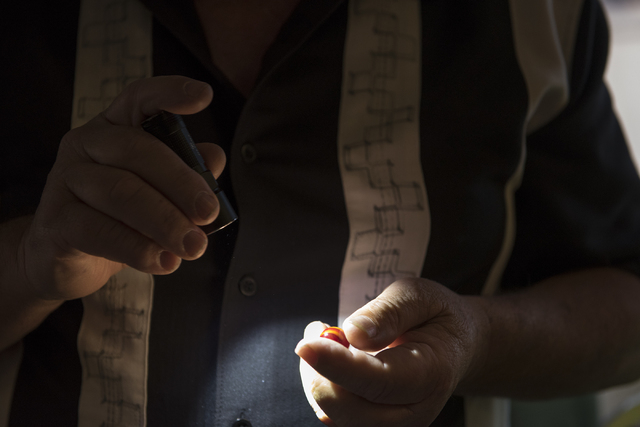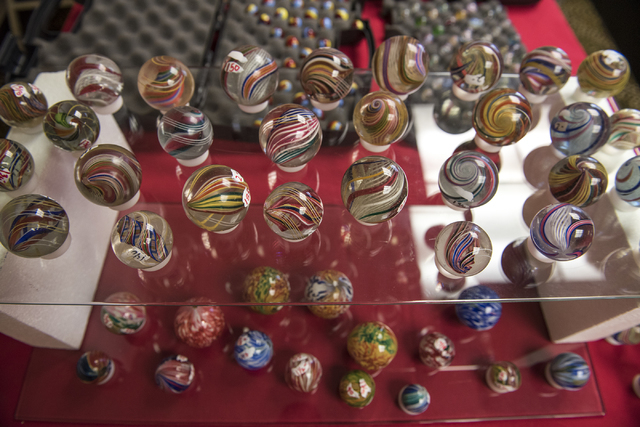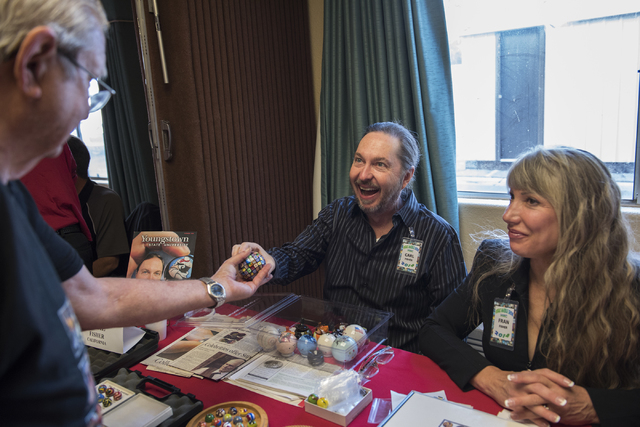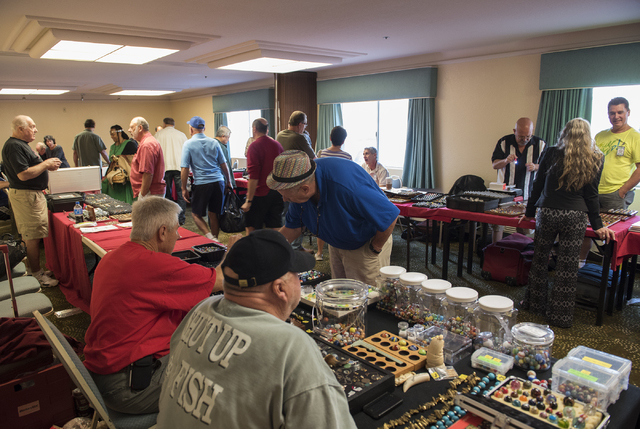Every marble tells a story
To the untrained eye, it is just a marble — small and round with swirls and splashes of color.
But to marble collectors, it tells a story and comes with a history.
That specific red is only used by certain companies. That swirl is a corkscrew swirl used by one company.
“Many of the collectors have made up names for the different types of marbles,” says Ernie Kirk, president of the International Association of Marble Collectors. “Like the tricolored ones we call Popeyes because the box they used to come in had Popeye on the box.”
The International Association of Marble Collectors gathers in Las Vegas every year, bringing out die-hard collectors from around the globe who want to trade and sell marbles. On the first Sunday in November, about 200 people come through the Fortune Hotel for the ninth annual show. They view collections of marbles of different eras, sizes, colors and designs.
Kirk, wife Dani and friend Lee Linne founded the association. The group is dedicated to preserving the history of marbles and to helping collectors find missing pieces to their collections.
Between shows in Seattle and Las Vegas, members, some from as far away as Finland and New Zealand, stay connected through newsletters and emails, sharing stories of treasures found and news on collections.
“It’s a diverse group,” Kirk says. “We have engineers and pilots and construction workers. Most of us grew up playing with marbles.”
In some shape or form, marbles have been around for centuries.
“You can trace it all the way back to the Egyptians,” he says.
Marbles can have their roots anywhere from pre-Civil War America to pre-World War I Germany.
“There were millions of marbles made in the ’20s and ’30s,” Linne adds. “There are probably only 1 percent accounted for.”
The first marbles were all handmade. Companies started to machine make marbles in the 1900s, Kirk says.
Mostly, collectors can tell handmade from machine-made marbles.
Though they may not have had the design patent, certain companies were known for certain corkscrews or colors within the marble.
“But marbles are made like they used to be,” Kirk says.
The industry captivates Leo Contreras, whose collection includes antiques from Germany that date back to the 1800s.
He is one of the convention’s vendors. Along with marbles, he is also selling the original boxes that some marbles came in.
“Not a lot of the boxes survived,” he says.
If marble collection and trading is going to survive, Contreras says, a younger generation — who didn’t necessarily play with marbles — needs to get involved.
“I think we need to get local schools involved,” he says. “I think we can rejuvenate the hobby.”
Marble making has slowed in recent years, Kirk says, and marbles are used for niche products such as the jingle people hear in spray paint cans.
But marble-making isn’t a lost art.
At the show, Carl Fisher sits at his table talking to potential buyers about his collection, which has taken eight years to build.
“You start out with $5 and $10 purchases,” he says. “Then you move up and might get one for $50.”
Instead of spending more money on marbles, his wife suggested he look into making his own.
“I saw a woman who had a pair of marbles as earrings,” he says. He thought they were antiques, but it turns out the woman had made them from clay.
Creating marbles can take as little as 15 minutes and as long as three days depending on the design and attention to detail.
In the palm of his hand, Fisher holds a marble a little bigger than a golf ball. The ball is covered in various images each smaller than a centimeter.
He has made designs such as tie dyes and rainbows. Whatever he can imagine.
“I even have my face on one,” he says. “I try to make them eye-catching.”
Fisher says many people buy his marbles as placeholders.
“It’s in a collection when you can’t find a certain piece so you buy something to hold the spot until you do,” he says.
Fisher also uses the convention to shop around to add to his collection. At the convention, he even swapped marbles with another collector who had something to offer.
Also at the show is Brian Esteep from Morphy Auctions in Pennsylvania. The company sells a variety of antiques, from cars to decorative art. Twice a year, it puts on a marble auction.
“It’s nice for people who might not be able to make it out to a convention like this,” he says.
The company auctioned off one of the most expensive marbles: $28,000 for a handmade version.
But expensive doesn’t necessarily mean most valuable for many of the collectors.
“I’ve been asked what one would I grab if I had to leave,” Linne says. “I have a couple.”
Linne and Kirk say they have marbles they’ve received or found along the way that might have little monetary worth but are priceless to them.
“It’s the ones that have sentimental value,” Kirk says.
During the gathering, collectors might just add another marble of sentimental value.
Though their collections sit in cases or in boxes, the collectors still love taking a moment to hold up marbles.
Many marble aficionados are enchanted by the swirls inside the little orbs. When they hold them up to the light, the marbles come alive.
“No collector is complete without a flashlight,” Kirk says. “When you hold it up to the light, you can really see the different variations of it. In the sun, that’s when you really see it.”
Contact reporter Michael Lyle at mlyle@reviewjournal.com or 702-387-5201. Follow @mjlyle on Twitter.

























